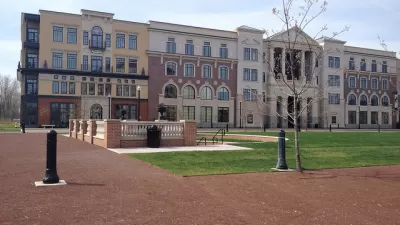A new book about unconventional suburbs challenges the perception that these were socially and racially homogenous places.

In an excerpt from her new book Radical Suburbs, Amanda Kolson Hurley describes various experimental communities that sprung up from the 1820s to the 1960s outside of cities and challenge conventional notions of American suburbs. "These groups had very different backgrounds and motivations, but all of them believed in the power of the local community to shape moral and social values, and in the freedom provided by outskirts land to live and build in new ways."
Hurley says that the perception of suburbs as filled with tracts of cookie-cutter homes where middle-class whites resided is not wrong, but it is a limited understanding of their diversity. Lower-income suburbs existed as did black and integrated suburbs, suburbs based on religious ideology, and suburbs founded by anarchists and socialists.
For Hurley, looking back at the past is important as demographic, social, and economic changes influence the transformation of present-day suburbs. "Heavy-handed zoning and land-use regulations might try to make time stand still, but nothing is predestined about the future of suburbia, where most Americans live. Instead of despairing over the suburbs’ problems, we should be inspired by suburban history to try to solve them."
FULL STORY: The Secret History of the Suburbs

Study: Maui’s Plan to Convert Vacation Rentals to Long-Term Housing Could Cause Nearly $1 Billion Economic Loss
The plan would reduce visitor accommodation by 25,% resulting in 1,900 jobs lost.

North Texas Transit Leaders Tout Benefits of TOD for Growing Region
At a summit focused on transit-oriented development, policymakers discussed how North Texas’ expanded light rail system can serve as a tool for economic growth.

Using Old Oil and Gas Wells for Green Energy Storage
Penn State researchers have found that repurposing abandoned oil and gas wells for geothermal-assisted compressed-air energy storage can boost efficiency, reduce environmental risks, and support clean energy and job transitions.

Santa Barbara Could Build Housing on County Land
County supervisors moved forward a proposal to build workforce housing on two county-owned parcels.

San Mateo Formally Opposes Freeway Project
The city council will send a letter to Caltrans urging the agency to reconsider a plan to expand the 101 through the city of San Mateo.

A Bronx Community Fights to Have its Voice Heard
After organizing and giving input for decades, the community around the Kingsbridge Armory might actually see it redeveloped — and they want to continue to have a say in how it goes.
Urban Design for Planners 1: Software Tools
This six-course series explores essential urban design concepts using open source software and equips planners with the tools they need to participate fully in the urban design process.
Planning for Universal Design
Learn the tools for implementing Universal Design in planning regulations.
Ascent Environmental
Borough of Carlisle
Caltrans
Institute for Housing and Urban Development Studies (IHS)
City of Grandview
Harvard GSD Executive Education
Toledo-Lucas County Plan Commissions
Salt Lake City
NYU Wagner Graduate School of Public Service




























